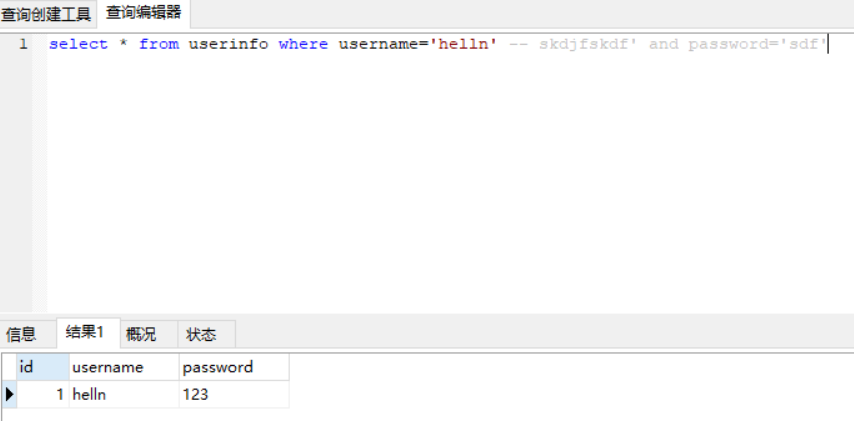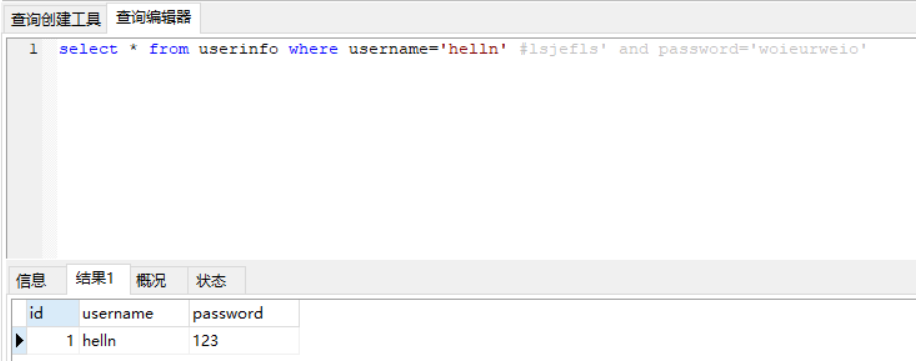pymysql简介
pymysql是python操纵mysql的一个模块,本质上是一个socket客户端
## pymysql使用
准备数据
#创建数据库db2,如果已存在,请忽略
CREATE DATABASE db2 DEFAULT CHARACTER SET utf8;
#创建用户表
CREATE TABLE `userinfo` (
`id` int(10) unsigned NOT NULL AUTO_INCREMENT COMMENT \'id\',
`username` varchar(20) NOT NULL COMMENT \'用户名\',
`password` varchar(32) NOT NULL COMMENT \'密码\',
PRIMARY KEY (`id`)
) ENGINE=InnoDB DEFAULT CHARSET=utf8 COMMENT=\'用户表\';
#插入一条数据
INSERT INTO `db2`.`userinfo` (`id`, `username`, `password`) VALUES (\'1\', \'helln\', \'123\');
### 实现
使用Python实现用户登录,如果用户存在则登录成功(假设该用户已在数据库中)
#导入模块
import pymysql
user = input(\'请输入用户名:\')
pwd = input(\'请输入密码:\')
# 1.连接
conn = pymysql.connect(host=\'127.0.0.1\', port=3306, user=\'root\', password=\'\', db=\'db2\', charset=\'utf8\')
# 2.创建游标
cursor = conn.cursor()
# 注意%s需要加引号
sql = "select * from userinfo where username=\'%s\' and password=\'%s\'" % (user, pwd)
print(\'sql语句:\',sql)
# 3.执行sql语句
cursor.execute(sql)
result = cursor.execute(sql) # 执行sql语句,返回sql查询成功的记录数目
print(\'返回记录数:\',result)
# 关闭连接,游标和连接都要关闭
cursor.close()
conn.close()
if result:
print(\'登陆成功\')
else:
print(\'登录失败\')
演示
输入正确用户名和密码
请输入用户名:helln
请输入密码:123
sql语句: select * from userinfo where username=\'helln\' and password=\'123\'
返回记录数: 1
登陆成功
输入错误时 ``` 请输入用户名:helln 请输入密码:234 sql语句: select * from userinfo where username=\'helln\' and password=\'234\' 返回记录数: 0 登录失败
<br>
## sql注入
sql注入有两种形式:用户名存在绕过密码、用户不存在绕过用户名和密码
### 用户名存在绕过密码
格式
存在的用户名\' -- 任意字符
或者
存在的用户名\' #任意字符
<br>
测试\'--
请输入用户名:helln\' -- skdjfskdf
请输入密码:sdf
sql语句: select * from userinfo where username=\'helln\' -- skdjfskdf\' and password=\'sdf\'
返回记录数: 1
登陆成功

<br>
测试\' #
请输入用户名:helln\' #lsjefls
请输入密码:woieurweio
sql语句: select * from userinfo where username=\'helln\' #lsjefls\' and password=\'woieurweio\'
返回记录数: 1
登陆成功

在navicat中可以看到-- 和#后面的都被注释掉了,所以只有username=\'helln\'起作用,自然也就能够查询到结果
<br>
### 用户名不存在,绕过用户名和密码
格式
任意用户名\' or 1=1 -- 任意字符
或者
任意用户名\' or 1=1 #任意字符
或者
任意用户名\' or \'任意字符\'=\'任意字符
<br>
注意:
- 用户名后面有一个单引号
- or前后都有空格
- 必须保证等式成立
<br>
测试
请输入用户名:sfhgk\' or 1=1 -- sfjeor
请输入密码:vnxlngf\' or 2=2 #sdfwer
sql语句: select * from userinfo where username=\'sfhgk\' or 1=1 -- sfjeor\' and password=\'vnxlngf\' or 2=2 #sdfwer\'
返回记录数: 1
登陆成功
<b><font color=\'#ff0000\'>sql注入的本质是(通过注释)构造恒为真的表达式绕过验证</font></b>
<br>
## 解决办法
原来我们是用字符串拼接做的
```python
sql="select * from userinfo where name=\'%s\' and password=\'%s\'" %(username,pwd)
print(sql)
result=cursor.execute(sql)
将上面的语句改为下面这样,注意一定不要再加引号了
#改写为(execute帮我们做字符串拼接,我们无需且一定不能再为%s加引号了)
sql="select * from userinfo where name=%s and password=%s" #!!!注意%s需要去掉引号,因为pymysql会自动为我们加上
result=cursor.execute(sql,[user,pwd]) #pymysql模块自动帮我们解决sql注入的问题,只要我们按照pymysql的规矩来。
## commit()提交 在数据库里增、删、改的时候,必须要进行提交,否则插入的数据不生效。
### 增
#导入模块
import pymysql
user = input(\'请输入用户名:\')
pwd = input(\'请输入密码:\')
# 1.连接
conn = pymysql.connect(host=\'127.0.0.1\', port=3306, user=\'root\', password=\'\', db=\'db2\', charset=\'utf8\')
# 2.创建游标
cursor = conn.cursor()
sql = "insert into userinfo(username,password) values (%s,%s)"
print(\'sql语句:\',sql)
# 3.执行sql语句,返回sql查询成功的记录数
#同时插入多条数据
result = cursor.executemany(sql,[(user+\'1\',pwd),(user+\'2\',pwd)])
print(\'返回记录数:\',result)
#一定记得commit
conn.commit()
# 关闭连接,游标和连接都要关闭
cursor.close()
conn.close()
#判断结果
if result:
print(\'ok\')
else:
print(\'error\')
### 改 ```python #!/usr/bin/env python # -*- coding: utf-8 -*- #导入模块 import pymysql
user = input(\'请输入用户名:\')
pwd = input(\'请输入密码:\')
1.连接
conn = pymysql.connect(host=\'127.0.0.1\', port=3306, user=\'root\', password=\'\', db=\'db2\', charset=\'utf8\')
2.创建游标
cursor = conn.cursor()
sql = "update userinfo set username = %s where id = \'8\'"
print(\'sql语句:\',sql)
3.执行sql语句,返回sql查询成功的记录数
修改一条数据
result = cursor.execute(sql,user)
print(\'返回记录数:\',result)
一定记得commit
conn.commit()
关闭连接,游标和连接都要关闭
cursor.close()
conn.close()
判断结果
if result:
print(\'ok\')
else:
print(\'error\')
<br>
### 删
```python
#!/usr/bin/env python
# -*- coding: utf-8 -*-
#导入模块
import pymysql
#删除不需要执行这2个input了
# user = input(\'请输入用户名:\')
# pwd = input(\'请输入密码:\')
# 1.连接
conn = pymysql.connect(host=\'127.0.0.1\', port=3306, user=\'root\', password=\'\', db=\'db2\', charset=\'utf8\')
# 2.创建游标
cursor = conn.cursor()
sql = "delete from userinfo where id = \'2\'"
print(\'sql语句:\',sql)
# 3.执行sql语句,返回sql查询成功的记录数
#删除一条数据
result = cursor.execute(sql)
print(\'返回记录数:\',result)
#一定记得commit
conn.commit()
# 关闭连接,游标和连接都要关闭
cursor.close()
conn.close()
#判断结果
if result:
print(\'ok\')
else:
print(\'error\')
查
查有三种:fetchone()、fetchall()和fetchmany
fetchone():获取下一行数据(第一次使用时是首行),返回值是一个元组
#导入模块
import pymysql
# 1.连接
conn = pymysql.connect(host=\'localhost\', port=3306, user=\'root\', password=\'\', db=\'db2\', charset=\'utf8\')
# 2.创建游标
cursor = conn.cursor()
sql = \'select * from userinfo\'
cursor.execute(sql)
# 查询第一行的数据
row = cursor.fetchone()
print(row) # (1, \'helln\', \'123\')
# 查询第二行数据
row = cursor.fetchone()
print(row) # (6, \'sophia\', \'123\')
# 4.关闭游标
cursor.close()
# 5.关闭连接
conn.close()
在fetchone示例中,在获取行数据的时候,可以理解开始的时候,有一个行指针指着第一行的上方,获取一行,它就向下移动一行,所以当行指针到最后一行的时候,就不能再获取到行的内容,所以我们可以使用如下方法来移动行指针: ```python cursor.scroll(1,mode=\'relative\') # 相对当前位置移动,整数向下移动,负数向上移动 cursor.scroll(2,mode=\'absolute\') # 相对绝对位置移动 ```
fetchall(): 获取所有数据,返回值是元组套元组 ```python #导入模块 import pymysql
1.连接
conn = pymysql.connect(host=\'localhost\', port=3306, user=\'root\', password=\'\', db=\'db2\', charset=\'utf8\')
2.创建游标
cursor = conn.cursor()
sql = \'select * from userinfo\'
cursor.execute(sql)
获取所有的数据
rows = cursor.fetchall()
print(rows)
4.关闭游标
cursor.close()
5.关闭连接
conn.close()
默认情况下,我们获取到的返回值是元组,只能看到每行的数据,却不知道每一列代表的是什么,这个时候可以使用以下方式来返回字典,每一行的数据都会生成一个字典:
```python
cursor = conn.cursor(cursor=pymysql.cursors.DictCursor) #在实例化的时候,将属性cursor设置为pymysql.cursors.DictCursor
fetchmany(): 获取多行记录,括号内的参数为获取的行数 ```python #导入模块 import pymysql
1.连接
conn = pymysql.connect(host=\'localhost\', port=3306, user=\'root\', password=\'\', db=\'db2\', charset=\'utf8\')
2.创建游标
cursor = conn.cursor(cursor=pymysql.cursors.DictCursor)
sql = \'select * from userinfo\'
cursor.execute(sql)
获取2条数据
rows = cursor.fetchmany(2)
print(rows)
4.关闭游标
cursor.close()
5.关闭连接
conn.close()